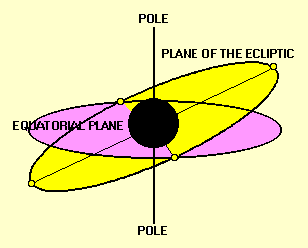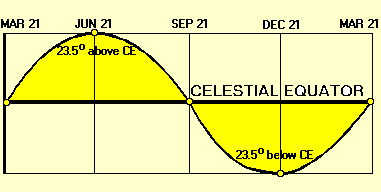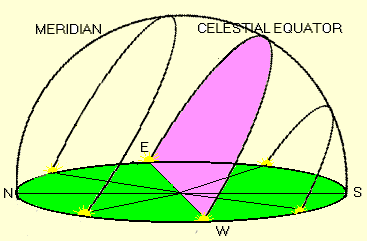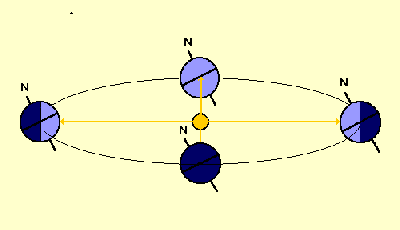|
APPARENT MOTIONS CONT.
APPARENT MOTION #2: REVOLUTION
The second apparent motion is due to revolution. Revolution refers to
one object going around another. Revolution causes an apparent path
of the sun around the Earth (in other words, the sun appears to revolve
around the earth) in the course of a year. Of course we know that
it is the Earth that orbits the sun, and that gives us an ever-changing
view of the sun against the background of fixed stars. It is how long it
takes to travel this path that dictates the length of the year.
The sun slowly drifts in front of the celestial sphere (the background
of stars) in such a way that it comes back in front of the same star once
a year. Thus it does a slow 360o circuit in the space of 365
1/4 days, or approximately 1o/day. Because these motions are
relative, we can just as well say that the celestial sphere drifts behind
the sun by 1o/day. Remember that from rotation, we know that
a change in location of one degree amounts also to a time difference of
4 minutes. Thus, when we look at the night sky, one consequence of revolution
is that stars rise 4 minutes earlier each night. Another way of saying
this, is that a star day (sidereal day) is only 23 hours, 56 minutes long,
whereas the day based on rotation relative to the sun (the solar day) is
24 hours long.
Moreover, the sun does not appear to travel along the celestial equator.
The apparent path of the sun, called the ecliptic, is tilted by 23.5 degrees
in relation to the Celestial Equator. Thus, over one revolution in the
span of a year, the path of the sun is above the Celestial Equator (N of
it) for half the year and below (S of it) for the other half. That
also means it is on it (crosses it twice a year. This tilt of the ecliptic,
along with the yearly revolution, is the fundamental cause of the seasons.
The Egyptians were the first to use revolution as a way of fixing
the year. They noticed that, once a year, the star Sothis (Sirius to us)
rises in line with the rising sun. They used this yearly occurrence as
a way to set their calendar and, for them, this astronomical event marked
the beginning of the new year.
 |
The second consequence of revolution is
a change in the position in the sun in comparison to the celestial equator.
The earth/sun line does not lie on the celestial equator. In fact, this
imaginary line, called the ecliptic, is tilted 23 1/2 degrees in relation
to the celestial equator. |
 |
Thus the apparent path of the sun against the celestial sphere,
called the ecliptic, varies over the course of a year, from 23.5o
above the celestial equator, to 23.5o degrees below it, crossing
it twice. |
 |
This leads to a change in the position
of the sunrise and sunset throughout the year, and a related change in
the length of the day. Note that the sun will rise due east and west only
when it is on the Celestial Equator. When the sun is above the CE, it will
rise north of east and set north of west. Conversely, when the sun's path
is below the CE it will rise south of east and set south of west. |
 |
The combination of the 23.5o angle between the ecliptic
and the celestial equator, and revolution also leads to the seasons. When
the earth is in the right hand position in the diagram, the northern hemisphere
is getting most of the sunlight, and it is June 21st, the day of the summer
solstice. Six months later, on December 21st, the day of the winter solstice,
the sun is 23.5o below the celestial equator, and it is the
beginning of winter in the northern hemisphere. In the intermediate positions,
the sun is on the celestial equator and both hemispheres are receiving
the same amount of sunlight. These are the equinoxes, days of equal day
and equal nights. March the 21st is the day of the vernal equinox, and
September 21st is the day of the autumnal equinox. |
|





